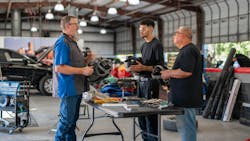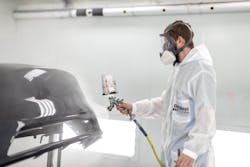The long weeks in August are often referred to as the dog days of summer. They’re hot, unforgiving, and they seem to drag on indefinitely.
During NFL training camp, which is actively underway, players are expected to learn the basics of their teams’ playbooks and practice the fundamentals that will lay the groundwork for a successful season.
It’s vital work, but to put it mildly, it’s less than enjoyable work: Repetitive drills for eight hours a day in the hot sun, frustrating learning curves and thankless work day in and day out for weeks on end, with the only thanks or reward being the possibility of making the roster for kickoff weekend.
It's grueling, and many players would prefer not to do it if they didn’t have to. Fast forward to January when playoffs start, however, and more often than not, it’s the teams that are the most fundamentally sound that are left standing. Those hard weeks and months before the season end up paying off with a chance at football immortality, and players on those teams will usually say that their success started all the way back in training camp.
Unfortunately, there aren’t any rings or trophies to be won in the collision industry like there are in sports, but the analogy still holds strong – training, thankless as it may be, is essential to a successful business, and a dedication to continual learning can help set your shop apart from the competition.
In largely the same way a head coach has to find ways to motivate his players through the slog of training camp, you may find that you, too, have to figure how to get employees energized and willing to participate.
Ultimately, if we’re not putting training first, we’re jeopardizing the quality and safety that our customers expect when they give us their keys.” - Adan Ibarra, Leading Edge Collision
Clear Culture and Expecations
Ibarra says he understands that it’s not easy to get everyone in your shop into a training-first mindset – with the number of tasks each employee has to take care of on a daily basis, it’s easy for a certification course or an online training module to get buried on the to-do list.
In his shop, Ibarra gives every employee, regardless of position, one hour a week to complete training courses. He says this helps establish an expectation that training isn’t optional in his shop.
“A lot of people in our industry can relate that it’s just so hard to put training first,” he says. “But ultimately, if we’re not putting training first, we’re jeopardizing the quality and safety that our customers expect when they give us their keys.”
We take a lot of pride in knowing that we want to continue the education for our employees. - Makenzie Tedder, CollisionRight
To help manage that expectation, Ibarra says he’s put his office manager in charge of keeping track of trainings for everyone in the shop. At the start of a week, he’ll check in to see how the previous week’s trainings went. His office manager will provide a quick run down of who completed what training or, more importantly, if someone didn’t complete a required module.
“When I get that feedback, it’s easy for me to go to an employee and just have a conversation like, ‘Hey, I noticed you missed one or two weeks of training this month. What happened?’” Ibarra says. “Just having that conversation, holding that accountability, tends to help fix those little problems and gets everybody engaged doing what’s expected of them.”
That expectation doesn’t have to change even your operation is bigger than one shop, too. Tedder manages the training for all 125 CollisionRight locations across the country, and she says there is a clear and consistent expectation that training is prioritized at each location.
“I think safety should be approached the same way regardless of the size. It should always be something that's important and should always be something that is a priority,” Tedder says. “Our number one goal at CollisionRight is to have all of our shops at I-CAR Gold status within six months of acquisition if they're not already. We take a lot of pride in knowing that we want to continue the education for our employees.”
It will take a clear, concerted effort from your shop’s leadership, but making it known that training is an expectation and not an option is an essential first step.
Make It Personal
Tedder acknowledges that just because CollisionRight has a consistent expectation for training, a one-size-fits-all approach isn’t going to be the most productive use of time.
“Not everybody learns the same way; not everybody teaches the same way,” Tedder says. “We try to give our employees all the knowledge that is necessary without dragging it out too long, and we try to make it very individualized to that person.”
As training coordinator, Tedder says she spends a lot of time trying to find the most up-to-date and engaging training modules that she can. She says I-CAR has a vast catalog of cutting-edge training that is more than just a presenter running through a slideshow.
Know What You Stand For
Ibarra says a culture of engagement with training and getting employees on board starts with you. When he first took over as owner of Leading Edge, he said he had a difficult time getting techs to take more than the bare minimum for training.
“One of my mentors always talked about non-negotiables. What are your non-negotiables?” Ibarra says. “I turned training into one of my non-negotiables.”
In addition to giving each employee an hour a week to do training, he put his shop’s mission statement on a banner and hung it up in the back of the shop. He held a meeting under that banner and connected the importance of always getting better to that mission statement. And the only way his team gets better, he says, is through training.
“I'm not going to be pulling teeth,” Ibarra says. “This is something that is just required. It has to happen.”
To help incentivize participation, Ibarra says he and his office manager would provide an occasional reward – such as a $25 gift card or something else small – to people who didn’t have to be reminded to do their training. From there, he says, word spreads pretty quickly, and soon more and more of his techs began to do the training.
Though the extra incentive helped, Ibarra says the most powerful thing he did to help lead that shift was to keep connecting the training back to their mission statement and remind his technicians about how their engagement will be a benefit to them over the course of their career.
“It’s a constant conversation,” Ibarra says. “Knowledge is power, and nobody can take that away from them. Whatever happens in their career, whether it’s with my shop or if they move somewhere else, this is only going to help them succeed.”
Ibarra says a lot of his employees, like a lot of people in the industry, take an immense amount of pride in their work and are generally self-motivated. By tying education and training to that pride, you can show a tangible connection between training and future opportunity.
That, he says, is when you know you have a culture of continuous education.
“I tell my team, whenever you’re wearing a Leading Edge shirt, it’s not just a uniform. It’s something we stand for,” Ibarra says. “If you don't have pride in what you do, then what are you standing for?”
About the Author

Noah Brown
Noah Brown is a freelance writer and former senior digital editor for 10 Missions Media, where he facilitated multimedia production several of the company's publications.





